
Interstellar travel is the hypothetical travel of spacecraft from one star system, solitary star, or planetary system to another. Interstellar travel is expected to prove much more difficult than interplanetary spaceflight due to the vast difference in the scale of the involved distances. Whereas the distance between any two planets in the Solar System is less than 55 astronomical units (AU), stars are typically separated by hundreds of thousands of AU, causing these distances to typically be expressed instead in light-years. Because of the vastness of these distances, non-generational interstellar travel based on known physics would need to occur at a high percentage of the speed of light; even so, travel times would be long, at least decades and perhaps millennia or longer.

The Restaurant at the End of the Universe is the second book in the Hitchhiker's Guide to the Galaxy comedy science fiction "trilogy" by Douglas Adams, and is a sequel. It was originally published by Pan Books as a paperback in 1980. The book was inspired by the song "Grand Hotel" by British rock band Procol Harum. The book title refers to Milliways, the Restaurant at the End of the Universe, one of the settings of the book. Elements of it are adapted from the radio series, primarily the Secondary Phase, although Milliways itself, Arthur and Ford's final fate come from Fits the Fifth and Sixth of the Primary Phase.
State of Decay is the fourth serial of the 18th season in the British science fiction television series Doctor Who, which was first broadcast in four weekly parts on BBC1 from 22 November to 13 December 1980.
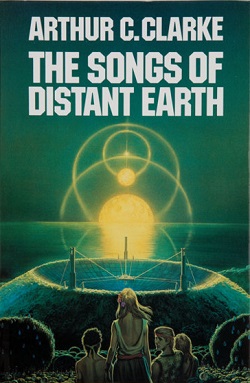
The Songs of Distant Earth is a 1986 science fiction novel by British writer Arthur C. Clarke, based upon his 1958 short story of the same title. Of all of his novels, Clarke stated that this was his favourite. Prior to the publishing of the novel, Clarke also wrote a short step outline with the same title, published in Omni magazine and anthologised in The Sentinel in 1983.
The Noon Universe is a fictional future setting for a number of hard science fiction novels written by Arkady and Boris Strugatsky. The universe is named after Noon: 22nd Century, chronologically the first novel from the series and referring to humanity reaching its noon in the 22nd century.
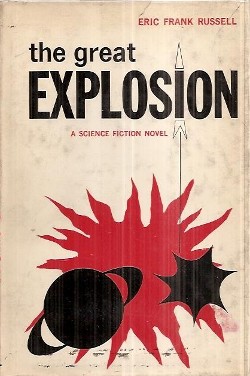
The Great Explosion is a satirical science fiction novel by English writer Eric Frank Russell, first published in 1962. The story is divided into three sections. The final section is based on Russell's 1951 short story "...And Then There Were None". Twenty-three years after the novel was published, it won a Prometheus Hall of Fame Award.
Space Mowgli, also known as The Kid, is a 1971 science fiction novel by Russian writers Boris and Arkady Strugatsky, set in the Noon Universe.

A Maze of Death is a 1970 science fiction novel by American writer Philip K. Dick. Like many of Dick's novels, it portrays what appears to be a drab and harsh off-world human colony and explores the difference between reality and perception. It is, however, one of his few to examine the human death instinct and capacity for murder and is one of his darkest novels.
Commander Perkins is a German science fiction series by H. G. Francis, published partly as audio plays and partly as a series of novels.
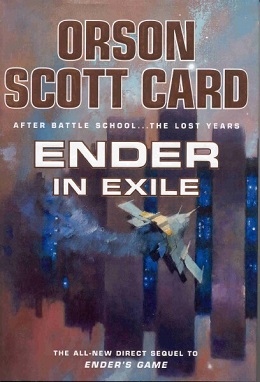
Ender in Exile is a science fiction novel by American writer Orson Scott Card, part of the Ender's Game series, published on November 11, 2008. It takes place between the two award-winning novels Ender's Game and Speaker for the Dead. It could also be considered a parallel novel to the first three sequels in the Shadow Saga, since the entirety of this trilogy takes place in the span of Ender in Exile. The novel concludes a dangling story line of the Shadow Saga, while it makes several references to events that take place during the Shadow Saga. From yet another perspective, the novel expands the last chapter of the original novel Ender's Game. On the one hand, it fills the gap right before the last chapter, and on the other hand, it fills the gap between the last chapter and the original (first) sequel. Ender in Exile begins one year after Ender has won the bugger war, and begins with the short story "Ender's Homecoming" from Card's webzine Intergalactic Medicine Show. Other short stories that were published elsewhere are included as chapters of the novel.

Space Apprentice, also known as Probationers, is a science fiction novel by Soviet-Russian writers Arkady and Boris Strugatsky, originally published in 1962. It is set in the Noon Universe following The Land of Crimson Clouds and "Destination Amalthea", hundreds of years before the other Noon novels.
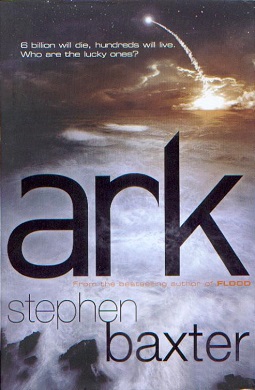
Ark is a 2009 hard science fiction novel by English author Stephen Baxter. It is a sequel to his 2008 novel Flood. Ark deals with the journey of the starship Ark One, and the continuing human struggle for survival on Earth after the catastrophic events of Flood. The series continues in three pendant stories, which are described in the plot summary below.
Starwolf is a series of three novels by Edmond Hamilton featuring heavy-worlder Morgan Chane. Chane was the son of a human missionary family to a heavier-than-Earth-normal world of Viking-like aliens. During the years of his life, his parents died and left him an orphan to be incorporated into the Starwolf society. As an adult he felt himself to be as much a Starwolf as his alien companions. After a dispute over plunder with a fellow Starwolf, Chane flees from Starwolf society. As a fugitive and hiding his ex-Starwolf status, Chane becomes part of a "Merc" human mercenary group commanded by a Merc named John Dilullo.

Cibola Burn is a 2014 science fiction novel by James S. A. Corey and the fourth book in The Expanse series. It follows the crew of the Rocinante as they join the flood of humanity out into the galaxy, using the gates built by the ancient civilization which also produced the protomolecule. Cibola Burn is heavily influenced by western stories, departing slightly from the previous themes of the series to tell a story of survival on the frontier. At the release of Cibola Burn, Orbit Books announced that James S. A. Corey would write three additional books in the series to bring the series to nine novels and various short stories. Cibola Burn serves as the basis for the fourth season of the television series The Expanse, which was released by Amazon Video December 13, 2019.

Planet of Light is a science fiction novel by American writer Raymond F. Jones, first published in 1953 by the John C. Winston Co. as part of its 35-book set of juvenile novels. Written as a sequel to Son of the Stars, the story follows Ron Barron and his family as they are taken to a planet in the Great Galaxy of Andromeda to participate in a meeting of an intergalactic analogue of the United Nations. They face the question if Earth is ready to join an intergalactic society.
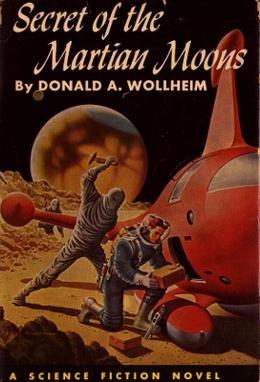
The Secret of the Martian Moons is a science-fiction novel by Donald A. Wollheim. It was first published in 1955 by the John C. Winston Company. Playing world-class hide-and-seek with the Martians, Nelson Parr believes that he has found them... until the real Martians show up. This is the second novel that Wollheim wrote for Winston, the other two being The Secret of Saturn's Rings (1954) and The Secret of the Ninth Planet (1959).
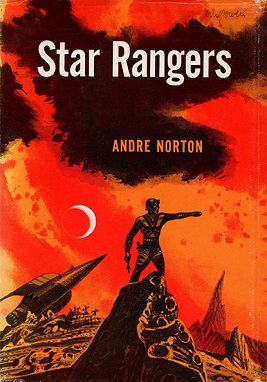
Star Rangers, also known as The Last Planet, is a science fiction novel by the American author Andre Norton. The novel was published on August 20, 1953, by Harcourt, Brace & Company. This is one of Norton's Central Control books, which lay out the history of a galactic empire through events suggested by Norton's understanding of Terran history.
The Miracle-Workers is a science fiction novella by Jack Vance published in 1958. It was first published in Astounding Science Fiction in the July 1958 edition. It is about humans on an Earth-like planet which was colonized by space travellers many centuries ago. In the intervening years, the inhabitants have lost their understanding of science and have regressed to a Medieval state of technology, aided by their use of voodoo, telepathy, and magic. Change is set in motion when a maverick apprentice Jinxman starts to rediscover the scientific method and learn about science.

Pastoral science fiction is a subgenre of science fiction which uses bucolic, rural settings, like other forms of pastoral literature. Since it is a subgenre of science fiction, authors may set stories either on Earth or another habitable planet or moon, sometimes including a terraformed planet or moon. Unlike most genres of science fiction, pastoral science fiction works downplay the role of futuristic technologies. The pioneer is author Clifford Simak (1904–1988), a science fiction Grand Master whose output included stories written in the 1950s and 1960s about rural people who have contact with extraterrestrial beings who hide their alien identity.